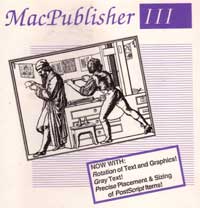Desktop Publishing (DTP)
 MacPublisher was the first Desktop Publishing program. It was written for the new Apple Macintosh and was one of the few applications introduced in 1984, the same year that Apple introduced the Macintosh. DTP competitors Ready,Set,Go! and Aldus PageMaker were introduced in 1985 when Apple delivered the 512K Macintosh (the "Big Mac").
MacPublisher was the first Desktop Publishing program. It was written for the new Apple Macintosh and was one of the few applications introduced in 1984, the same year that Apple introduced the Macintosh. DTP competitors Ready,Set,Go! and Aldus PageMaker were introduced in 1985 when Apple delivered the 512K Macintosh (the "Big Mac").
MacPublisher was developed by Bob Doyle, the eleventh Macintosh software developer outside the original Apple team. It was distributed by Boston Software Publishers.
Built on graphics primitives like QuickDraw that Bill Atkinson had originally developed for the Apple Lisa computer, MacPublisher included WYSIWYG layout for multi-column text and graphics. QuickDraw was incorporated in the PASCAL toolbox for the new Macintosh and had been the basis for MacPaint.
The Desktop Publishing industry exploded in the year 1985 with the introduction of the Apple LaserWriter printer in January and in July the 512K "Big Mac" and Aldus Corporation's PageMaker, which rapidly became the DTP industry standard software.
It was Paul Brainerd, Aldus' chairman, who gave the industry the name "desktop publishing." MacPublisher had been called "electronic publishing," after the industry then led by Atex Corporation, of which Brainerd had been a vice president.
MacPublisher was the first non-Apple application program to print in color on the ImageWriter II. It introduced spot color to desktop publishing. MacPublisher III was the first DTP program to rotate text and graphics, using a table look-up for the necessary sine functions in one-degree increments.
MacPublisher builds a page differently from PageMaker and ReadySetGo; instead of creating an actual image of the page with all the text and graphics, MacPublisher created a page mockup that contains only rectangles that represent the location and size of text and graphic elements, and stored the elements as special text and picture files that you edit separately from the page layout. MacPublisher rebuilds a page whenever it changes. It took this approach to allow creation of master pages, repeating elements, and predefined "canned" page layouts; to help prevent data loss on machines with limited memory (MacPublisher can run with as little as 128K RAM); and to facilitate the programming for the automatic table of contents and automatic page jump ("continued on page n") features. Since the page layout is independent of the text and graphic content, you can easily create publication formats which you can reuse as you need them. This reusable formats feature can be especially useful for creating catalogs or other publications in which you want the format to remain the same but in which you need to update or replace information on a regular basis. MacPublisher features either automatic or manual kerning to correct printer spacing idiosyncrasies.
MacPublisher included unusual desktop accessories such as a scissor tool to cut columns of text and paste the remainder into another page, a camera tool for capturing graphics from MacPaint, and a see-through ruler that could be moved around the page for measurements.
MacPublisher was sold in 1986 to Esselte Letraset, whose business in press-down dry transfer lettering was evaporating with competition from laser printers, notably Apple's pioneering LaserWriter printer. It was briefly sold as LetraPage, but dropped from the market when Letraset subsequently acquired Ready,Set,Go! from Manhattan Graphics.
Bob wrote MacPublisher so he could use it himself to write and self-publish some books on philosophy and physics. He was distracted by his entrepreneuring for decades, but finally started publishing using Adobe InDesign, the modern successor to PageMaker, in 2011, when he was 75 years old.
Free Will: The Scandal in Philosophy was published in June 2011.
480 pages, 40 figures, 15 sidebars, bibliography, glossary, index.
Philosophers who want to review it can download a PDF or a reflowable eBook, with hyperlinked index.
PDFs of the individual chapters are here.
Great Problems in Philosophy and Physics Solved? was published in September 2016
472 pages, 45 figures, bibliography, index.
Philosophers who want to review it can download a PDF or a fixed layout eBook or a reflowable eBook, all with hyperlinked indexes.
PDFs of the individual chapters are here.
Metaphysics: Problems, Paradoxes, and Puzzles Solved? was published in December 2016
428 pages, 13 figures, bibliography, index.
Philosophers who want to review it can download a PDF or a fixed layout eBook or a reflowable eBook, all with hyperlinked indexes.
PDFs of the individual chapters are here.
My God, He Plays Dice! How Albert Einstein Invented Most of Quantum Mechanics, was published in March, 2019
452 pages, 71 figures, bibliography, index.
PDFs of the draft chapters are here.
Since 2004, Bob's website informationphilosopher.com, has grown to contain enough material for perhaps five more books. The site has over 1000 unique new visitors every day. At 83, Bob looks forward to producing those books in the next several years, time permitting.
His new website, metaphysicist.com, has the material that formed his third book - Metaphysics.
References
- ^ The Art of Desktop Publishing, by Tony Bove, Cheryl Rhodes, and Wes Thomas, Bantam, 1986, p.182
- ^ Desktop Publishing, by Frederic E. Davis, John Barry, and Michael Wiesenberg, Dow Jones Irwin, 1986, p.98
- ^ Desktop Publishing from A to Z, by Bill Grout, Irene Athanasopolous, and Rebecca Kutlin, Osborne/McGraw-Hill, 1986, p.140
|
|